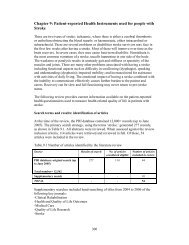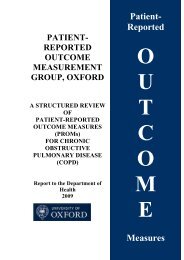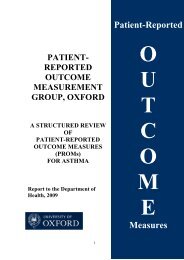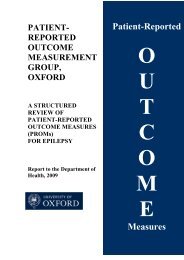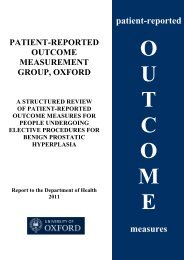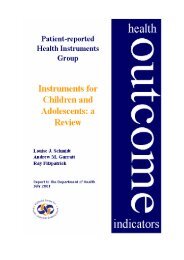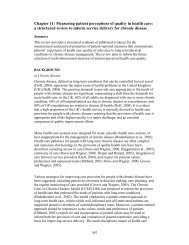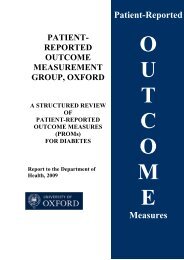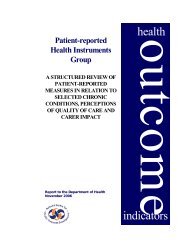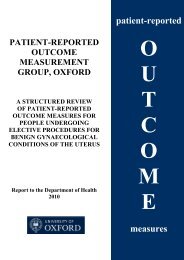2010 review - Patient-Reported Outcomes Measurement - University ...
2010 review - Patient-Reported Outcomes Measurement - University ...
2010 review - Patient-Reported Outcomes Measurement - University ...
Create successful ePaper yourself
Turn your PDF publications into a flip-book with our unique Google optimized e-Paper software.
Responsiveness of the NHP was supported in the study by Caine and colleagues (1991, UK)<br />
by significant improvements in all domains at three months, sustained at one year. There<br />
were also statistically significant score improvements for both treatment groups in all<br />
domains in the study by Pocock and colleagues (1996, UK).<br />
Interpretation of NHP scores was facilitated in the study by Pocock and colleagues (1996,<br />
UK) by classifying patients into four categories of impairment for each domain, depending on<br />
the number of items with ‘yes’ (i.e. negative) responses.<br />
c. SF-36 (Ware and Sherbourne, 1992; Ware, 1997)<br />
The SF-36 is a generic health status instrument capturing both mental and physical aspects of<br />
health; it is intended for application in a wide range of conditions and with the general<br />
population. The measure comprises 36 items assessing health across eight domains, namely<br />
bodily pain (BP: two items), general health perceptions (GH: five items), mental health (MH:<br />
five items), physical functioning (PF: ten items), role limitations due to emotional health<br />
problems (RE: three items), role limitations due to physical health problems (RP: four items),<br />
social functioning (SF: two items), and vitality (VT: four items). An additional health<br />
transition item, not included in the final score, assesses change in health. All items use<br />
categorical response options (range: 2-6 options). Scoring uses a weighted scoring algorithm<br />
and a computer-based programme is recommended. Eight domain scores give a health<br />
profile; scores are transformed into a scale from 0 to 100, where 100 denotes the best health.<br />
Scores can be calculated when up to half of the items are omitted. Two component summary<br />
scores for physical and mental health (PCS and MCS, respectively) can also be calculated.<br />
The SF-36 can be self-, interview-, or telephone-administered.<br />
Thirty-nine studies were identified supporting the use of the SF-36 with patients undergoing<br />
elective coronary procedures; of these, eight studies were carried out in the UK (Agarwal et<br />
al., 2009; Ascione et al., 2004; Kim et al., 2005; Lee, 2008; Lindsay et al., 2000; Pocock et<br />
al., 2000; Schroter & Lamping, 2006; Thornton et al., 2005). Thirty studies examined<br />
outcomes in CABG patients, 13 were concerned with outcomes of PCI; four studies<br />
examined both CABG and PCI. About half of the studies were published in the last five<br />
years.<br />
Internal consistency reliability of the SF-36 was supported with Cronbach’s alpha ranging<br />
from 0.73 (GH) to 0.90 (PF) in a large study of patients undergoing CABG and/or valve<br />
surgery (McCarthy et al., 1995; PSOCS study). Similar values were found in a study<br />
comparing generic and specific measures for measuring HRQoL after PCI (Krumholz et al.,<br />
1996). Cronbach’s alpha exceeded 0.85 for all subscales in a study comparing outcomes<br />
following coronary stenting versus balloon angioplasty (Krumholz et al., 1997), ranged 0.80-<br />
0.94 in the Stent-PAMI trial (Rinfret et al., 2001), and exceeded 0.80 in a postal survey<br />
assessing QoL in women after either an acute cardiac event or CABG (Worcester et al.,<br />
2007). Good internal consistency was also reported in a study examining differences in<br />
recovery outcomes for two groups of older adults undergoing cardiac rehabilitation (CR)<br />
post-CABG (Dolansky & Moore, 2004), with high alpha coefficients of 0.84 (pre-test) and<br />
0.81 (post-test) for the PCS, and 0.86 (pre-test) and 0.84 (post-test) for the MCS. High<br />
Cronbach’s alpha values in six of the domains (0.82 and above) were reported in a postal<br />
survey of post-CABG patients undergoing CR (Hawkes et al., 2003).<br />
The PF subscale correlated strongly with the CCS classification in the 1997 study by<br />
Krumholz et al. (1997), supporting construct validity of the measure. Construct validity of the<br />
14



